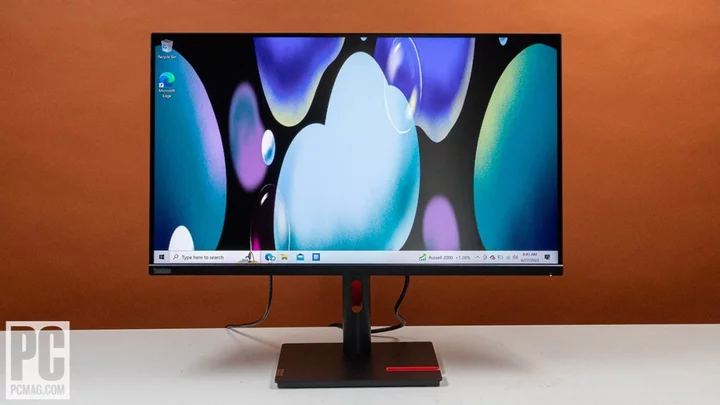Though it shares a nearly identical name and some physical attributes with the Lenovo Legion Y32p-30, the Lenovo ThinkVision P32p-30 ($1,200) couldn’t serve a more different role than the Y32p-30, which is designed for gaming. With an emphasis on visual clarity over raw performance, the P32p-30 is a 4K UHD monitor with a 31.5-inch IPS panel. It's aimed at productivity and even some light content creation work, but it handles neither exceptionally well. While it may catch the eye of power users and video editors, the high price, relatively high response times, and low maximum brightness will have users looking to more capable and less-expensive options like the HP Z32k.
A Monitor Made for the Office
Visually, the ThinkVision is not much different from the Lenovo Legion Y32p-30. Both are 31.5 inches when measured diagonally, and both feature thin bezels that wrap their screens, giving a contemporary look and feel. The differences become more apparent upon closer inspection, as the ThinkVision opts for a small and sturdy square base instead of the Y32p-30’s wide V-stand. A slit across the stand adds a pop of color as well as a place to tuck any loose wires.
Measuring 23.6 by 28.1 by 9.2 inches (HWD), the ThinkVision is just slightly taller than the Legion Y32p-30, the HP Omen 32q, and the Asus ProArt Display OLED PA32DC. The monitor weighs just over 16 pounds without its stand. With it, the scale climbs to 22.3 pounds. That's still pretty lightweight, and the monitor is dexterous, too, offering angle, swivel, and height adjustment as well as a 90-degree rotation for vertical work with the screen in portrait orientation.
(Credit: Molly Flores)Turning the monitor around to observe its port hub, you’ll find that the ThinkVision comes equipped with a good amount of connectivity options. The port hub includes Thunderbolt 4 in and out ports, one HDMI 2.0 connector, one DisplayPort, an Ethernet jack, one USB-Type B port, four USB-A connectors, and a trusty 3.5mm headphone jack. The lack of an HDMI 2.1 port might give you pause at first, but considering the display's refresh rate doesn’t go higher than 60Hz, there’s probably no need for it. HDMI 2.1 allows for resolutions beyond 4K and higher refresh rates.
You also might be wondering about the lack of USB-C connectivity in the monitor's spec sheet. In fact, Thunderbolt ports and USB-C ports perform the same function and use the same oval-shaped connectors, but the draw of Thunderbolt is its faster throughput speeds. (You can read more about how similar and how different they are in our Thunderbolt vs. USB-C explainer.)
(Credit: Molly Flores)Back to the screen itself: The ThinkVision P32p-30 is a UHD 4K IPS display. IPS displays are a favorite for mainstream gaming monitors thanks to their good response times, solid color accuracy, and wide viewing angles. We've seen IPS response times dip below 1ms, but the ThinkVision advertises a 4ms response time in Extreme mode and a 6ms response time in Normal mode. Higher response times lead to compromised motion clarity, resulting in a blurrier picture during scenes with movement. It’s not really noticeable when dealing with larger objects, and in playing a handful of 4K videos for anecdotal testing, the screen did not present any noticeable issues. Still, finer details could be lost because of the higher response times.
The monitor also supports both PIP (picture-in-picture) and PBP (picture-by-picture) modes for multitaskers. PIP mode allows you to simultaneously view content from two separate machines with one window inset into the other, while PBP mode displays different source devices simultaneously on the left and right sides of the screen. The ThinkVision supports up to four windows at one time, which is excellent for multitaskers, but with less than 32 inches of real estate, things can get pretty busy, pretty fast.
(Credit: Molly Flores)Navigating the ThinkVision's customization menus, you’ll find DCI-P3, sRGB, and BT.709 video modes for viewing content across various color spaces, which should prove useful to video and photo editors.
Testing the ThinkVision P32p-30: Could Be Brighter
The Lenovo ThinkVision P32p-30 has the makings of a fine monitor, but does it have enough performance to be worthy of your hard-earned $1,200? To quantify the monitor’s abilities, we put it to the test, measuring color gamut, brightness, color accuracy, and contrast ratio using our Calman monitor calibration software, a Murideo Six-G window signal generator, and a Klein K-80 colorimeter.
Our first test measures the display's maximum brightness over an SDR signal in its default picture mode. The ThinkVision P32p-30 reached 268 nits (candelas per square meter), below its rated 350-nit brightness rating. The monitor is not VESA DisplayHDR certified, so we did not subject it to HDR brightness tests.
Turning to the monitor's color-gamut coverage, the ThinkVision P32p-30 spanned 99% of the sRGB palette, 83% of Adobe RGB, and 88% of DCI-P3—respectable numbers, but we’ve seen better in more affordable monitors like the Lenovo ThinkVision P27u-20.
(Credit: Molly Flores)Next, we measure color accuracy. The higher a monitor's Delta E measurement, the more its colors tend to stray from their intended hues. A value under 1 is ideal for most monitors. In the case of the ThinkVision P32p-30, we recorded a respectable Delta E of 1.3. Professional content creators and video editors should seek monitors dedicated to their craft, like the ViewSonic VP2785-4K, but the ThinkVision P32p-30 lends itself to some light content creation work thanks to its relatively low Delta E score.
Our final test with the Klein colorimeter measures the screen's contrast ratio, meaning the difference in luminance between the brightest white and darkest black that a monitor can produce. The ThinkVision 32p-30 managed a contrast ratio of 1,204:1. That's a good result, slightly better than the monitor's 1,000:1 rating, and it falls in line with the static contrast ratios that other IPS panels promise, like the Omen 32q.
Verdict: Think Again For Better Vision
Overall, the ThinkVision P32p-30, much like the Legion Y32p-30, is an acceptable monitor, if one that’s not really remarkable. Its color results are good but not great, its response times could be better, and it’s marred by low brightness and a lack of HDR certification. These deficiencies combined with a high price hold it back from earning a solid recommendation, even as a second monitor. It does have a lot of connectivity options, but for under $1,000 you can find superior options like the HP Z32k G3 USB-C. We might be inclined to pick up the P32p-30 after a significant price drop, but we'll be waiting until then.









